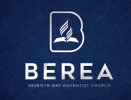The Berea Story
The Berea Seventh-day Adventist Church has roots that are rich with history.
During the early part of the 2oth century, a minister by the name of Elder Sidney Scott, from the Carolina Conference of the Seventh-day Adventist, came to Sumter to begin evangelistic meetings. His mission was to carry on these meetings with the hope that a future church would blossom. His dream became a reality.
Elder Scott began his evangelistic meetings about fourteen miles outside of the city in a section of the country that is known today as Wedgefield. He was welcomed by two families who took turns allowing evangelistic meetings to be held in their homes. James Granderson and Jake Strother, along with their families, were the first to hear the third angel's message in the county of Sumter. The message was taught to other families as well, but only the Granderson and Strother families were converted and accepted God's love and plan of salvation.
After these families accepted Christ, the Lord continued to bless them with an old house in which to worship. This house was located in the city of Sumter on Liberty Street, near the fairgrounds. Since these were the only families to accept the message in the Sumter area, Elder Scott was eager to teach them and to help them grow in the Lord. The Granderson and the Strother families would travel by horse and wagon every Sabbath from Wedgefield to Sumter to receive God's word. In the winter time, due to the long ride, the families would heat bricks and wrap them with cloth. These were used to keep the children's feet warm.
The Sabbath meetings became monthly, then weekly, and eventually more families accepted Jesus Christ as their Lord and Savior and joined the group. After the group of worshipers grew too large for the old house, it was decided that land should be purchased and a church built.
On February 27, 1917, a plot of land, situated in the Western part of the city of Sumter, in the State of South Carolina was sold to local church elders and T.W. James of the Carolina Conference of the Seventh-day Adventist. The first Seventh-day Adventist Church in the history of Sumter was erected on this land and was called the Sumter Seventh-day Adventist Church of the Carolina Conference of the Seventh-day Adventist.
After the completion of a new church building and ten years of faithful service, the local Elders were succeeded by new Elders who continued the superb leadership of the Sumter Church. The congregation was growing leaps and bounds and it was then that the members saw the need for a church school. This led to our first Adventist Elementary Academy being established and classes were held in the church.
The church continued to grow and the name was eventually changed to the St. Mark Seventh-day Adventist Church. St. Mark was not only blessed with a large membership and a functioning church academy, but the Lord also sent thirty-two of his best shepherds to serve the congregation.
In 1979, the St. Mark S.D.A Church congregation had once again outgrown its building. A member of St. Mark contacted the South Atlantic Conference of Seventh-day Adventists in Atlanta, Georgia, and informed him that there was 12.5 acres of land for sale in the city of Sumter. This land was then known as the Stonehill School, 675 South Lafayette Boulevard, and was thought to be the perfect site for a large church, church academy, and other facilities. Through the efforts of both Elders and members, funds were raised to purchase this property as the new home for the St. Mark Seventh-day Adventist Church.
On August 18, 1990 with the new Sanctuary foundation laid, it was felt that the new church, with its active Junior Academy, Dorcas Center, and Future Activity Center, needed a new name. By majority vote, the St. Mark Seventh-day Adventist Church became the Berea Seventh-day Adventist Church Complex.
Praise the Lord! Glory to His name!
Adapted from "The Story of Berea"
Emmanuel T. Taylor
Author
Beulah Brooks and Gabrella Robinson
Church Historians
